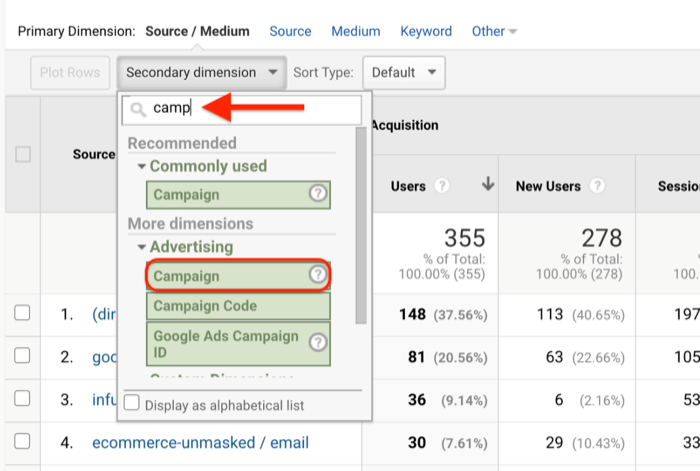Insights into the 'Secondary Dimension' in Google Analytics: A Thorough Explanation
Wiki Article
Revealing the Intricacies of Secondary Measurement in Google Analytics: a Comprehensive Overview on Just How It Works
Navigating the intricate realm of secondary dimensions in Google Analytics is a job that calls for a keen understanding of how this attribute runs within the platform. As digital landscapes advance and data ends up being increasingly vital for decision-making, grasping the subtleties of second dimensions can be the trick to unlocking useful understandings.Fundamentals of Additional Dimension in Google Analytics
When analyzing information in Google Analytics, making use of the secondary dimension function supplies useful understandings right into the efficiency of different metrics. The additional dimension allows individuals to even more explore their information by including an additional layer of information to their key dimensions. By doing so, experts can get a more detailed understanding of the variables affecting their internet site's performance.In Google Analytics, the primary measurements represent the main groups of information, such as web traffic sources or gadgets. When a secondary measurement is used, it provides a deeper degree of granularity by revealing another element of the information within the picked key dimension. For instance, if the main dimension is 'Traffic Source,' including an additional dimension like 'Touchdown Web page' can reveal which certain pages are driving website traffic from each resource.
This attribute is especially beneficial for recognizing patterns, relationships, and fads that may not be quickly obvious when checking out the data from a solitary measurement. By leveraging the secondary measurement in Google Analytics, customers can uncover useful insights that can notify tactical choices and optimizations to boost website efficiency.
Establishing Secondary Measurement Reports
Increasing on the insights gained with the usage of second dimensions in Google Analytics, the procedure of establishing up second dimension reports entails setting up additional layers of information to additionally improve the deepness of evaluation. When the key report is chosen, customers can click on the "Second dimension" tab located over the data visualization location. From there, a drop-down menu will appear, supplying a variety of choices to choose the additional measurement that best matches the main data collection.Leveraging Secondary Measurements for Insights
Utilizing secondary measurements in Google Analytics offers a tactical strategy to extracting nuanced insights for educated decision-making in on the internet company optimization. By combining key dimensions with second dimensions, services can dive deeper right into their data to reveal valuable connections and patterns that might not be quickly evident. For instance, by segmenting internet site web traffic by geographical location (primary measurement) and after that including a second dimension like tool category, organizations can determine if specific areas prefer accessing the website through mobile or desktop.Furthermore, leveraging additional measurements allows services to obtain a much better understanding of customer habits and preferences. Evaluating conversion rates based on website traffic sources (main measurement) along with the additional dimension of landing pages can disclose which specific pages are most reliable in driving conversions for natural search web traffic versus social media web traffic. These understandings can then notify advertising and marketing approaches and internet site optimization initiatives to boost general performance and take full advantage of ROI.
Advanced Methods for Additional Dimensions
To further draw out intricate insights and boost data-driven decision-making within Google Analytics, applying innovative methods for making use of additional dimensions is crucial in opening much deeper layers of important information for service optimization. One sophisticated method is making use of custom-made dimensions and metrics, enabling the tracking of specific individual interactions or actions that are not caught by default in Google Analytics. look at this web-site By defining and carrying out custom-made measurements, organizations can tailor their monitoring to align with unique organization objectives and purposes.Another sophisticated method involves the usage of filters in combination with secondary dimensions. Filters make it possible for users to refine the data presented in Google Analytics records, offering more targeted and relevant understandings. By applying filters tactically with additional dimensions, companies can sector information more successfully, resulting in a more clear understanding of individual actions and efficiency metrics.

Optimizing Information Evaluation With Secondary Dimensions

Moreover, optimizing information evaluation with secondary measurements entails try out different combinations to determine patterns and what is a “secondary dimension” in google analytics? relationships that may not be promptly noticeable. This iterative approach enables analysts to tweak their coverage and focus on one of the most relevant information points for their business goals. Ultimately, by leveraging secondary dimensions successfully, analysts can improve the accuracy and effectiveness of their information analysis initiatives in Google Analytics.
Verdict
In verdict, recognizing the intricacies of second measurements in Google Analytics is vital for getting much deeper understandings right into website efficiency. By establishing additional measurement reports, leveraging them for insights, and making use of advanced techniques, analysts can optimize data analysis and make informed decisions. This thorough overview has supplied an in-depth introduction of how second measurements work and their value in enhancing the analytical capabilities of Google Analytics individuals.The her explanation second dimension enables customers to better dissect their information by adding an added layer of details to their main measurements. When a secondary dimension is applied, it provides a much deeper degree of granularity by showing an additional aspect of the data within the picked primary dimension.Increasing on the insights gained with the utilization of secondary measurements in Google Analytics, the procedure of setting up additional dimension reports includes configuring added layers of data to better enhance the depth of analysis. By integrating main measurements with secondary dimensions, organizations can dig much deeper right into their data to uncover important connections and patterns that may not be instantly evident. One way to optimize data evaluation with secondary dimensions is to integrate them with main dimensions to get a more detailed view of site performance.
Report this wiki page